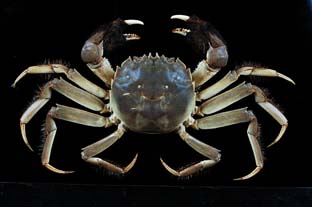
The Parc Científic’s Institut Cavanilles de Biodiversitat i Biologia Evolutiva is developing a study on the Chinese crab’s genes (Eriocheir sinensis). This type of crab has invaded the rivers of Europe and North America from its native region in Asia. This study takes place under the recent collaboration between Universitat de València and the National Taiwan University. The researchers will also analyze the migratory routes of this kind of crab, already spotted in Vigo and Seville.
The researcher of Institut Cavanilles, Ferran Palero, thinks that the crab’s larvae arrive to the European continent through the ballast waters of commercial ships and they colonize our rivers. ‘The adult crabs go down the river to reproduce and to have new larvae in salt water. During this migration they create problems because they block pipes and cooling systems’, he added.
This study is relevant to human health, because they act as vectors of the lung parasitoses (Paragonimus westermani). Regarding the economical effects, in Germany, the invasion of the Chinese crab has cost around 80 million Euros, but in Spain this cost has not been determined yet. They have been spotted in Vigo, in the port of Seville and in a place near the Doñana national park. The crabs have not arrived to the Valencian rivers yet.
Experts inform that large colonies of this crab can alter the food chains and the density and growing of different species because of the Chinese crab’s predatory skills. ‘Nowadays, capturing the adult crabs in the only way of controlling the crabs colonies, but this task is not enough’, states Ferran Palero.
The gene study is aimed at knowing the migratory routes of this crab. In the first place, a genetic classification of the crabs collected in China, Taiwan and Japan will be done and this information will be used to define the origin of the colonies spotted in Europe. The identification of these will allow to discover the migratory routes and to have a better control of the species.
Chan’s research, aimed at knowing whether Taiwan or Japan’s Eriocheir is the same of China’s, has an economical element as well, since the Chinese crab is a very valued food in Asia, where almost a 100 dollars are paid for a kilo of this crab.
Molecular analysis of crabs and lobsters
Another research to be carried out by the Valencian and the Taiwanese researchers is the molecular analysis of some species as crabs and lobsters, which are found in the Sea of China and in the Mediterranean Sea. ‘We decided to use the genetic analysis to confirm if the species are really the same or they are criptic species, so to speak, species which cannot be morphologically distinguished but which form independent evolutionary units’, finishes Ferran Palero.
Last update: 10 de january de 2012 08:17.
News release



















